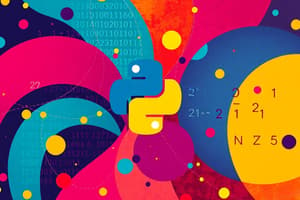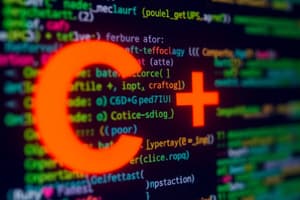Podcast
Questions and Answers
What is a critical limitation of stack memory?
What is a critical limitation of stack memory?
- It has a fixed size that can lead to stack overflow. (correct)
- It is accessible from anywhere in the program.
- It allows infinite memory allocation.
- It can result in memory leaks if not managed properly.
How is memory managed in the heap compared to the stack?
How is memory managed in the heap compared to the stack?
- Memory in the stack persists beyond the function scope.
- Memory in the heap is automatically managed.
- Memory in the stack can only be allocated at runtime.
- Memory in the heap must be manually allocated and deallocated. (correct)
Which statement best describes the lifetime of stack-allocated variables?
Which statement best describes the lifetime of stack-allocated variables?
- They are destroyed when the program finishes running.
- They remain in memory after the function returns.
- They persist for the entire program execution.
- They are accessible only during the function execution that created them. (correct)
Which of the following functions is used for dynamic memory allocation?
Which of the following functions is used for dynamic memory allocation?
What is a significant advantage of using heap memory?
What is a significant advantage of using heap memory?
Why might a programmer prefer stack memory over heap memory?
Why might a programmer prefer stack memory over heap memory?
Which option correctly contrasts the scope of stack and heap memory?
Which option correctly contrasts the scope of stack and heap memory?
What happens when memory allocated on the heap is not deallocated?
What happens when memory allocated on the heap is not deallocated?
What is one principle that allows functions to be reused across different programs?
What is one principle that allows functions to be reused across different programs?
Which component of a function declaration specifies its usage without detailing implementation?
Which component of a function declaration specifies its usage without detailing implementation?
What is the significance of the Single Responsibility Principle in function design?
What is the significance of the Single Responsibility Principle in function design?
Which of the following correctly represents calling a function in C?
Which of the following correctly represents calling a function in C?
Which of the following is NOT a benefit of using functions in programming?
Which of the following is NOT a benefit of using functions in programming?
Which of the following concepts allows functions to be implemented with minimal understanding of their internals?
Which of the following concepts allows functions to be implemented with minimal understanding of their internals?
What does decomposition in function design refer to?
What does decomposition in function design refer to?
What role does the main function typically take in relation to other functions in a program?
What role does the main function typically take in relation to other functions in a program?
What is the correct way to declare a two-dimensional array in C for 2 teams with 4 players each?
What is the correct way to declare a two-dimensional array in C for 2 teams with 4 players each?
Which of the following statements is true about memory locations of variables after assignment?
Which of the following statements is true about memory locations of variables after assignment?
In the context of dynamic memory allocation, which of the following statements is true?
In the context of dynamic memory allocation, which of the following statements is true?
What is the total number of elements in a two-dimensional array declared as int teamPlayerIDs[NUM_TEAMS][NUM_PLAYERS]; with NUM_TEAMS defined as 2 and NUM_PLAYERS as 4?
What is the total number of elements in a two-dimensional array declared as int teamPlayerIDs[NUM_TEAMS][NUM_PLAYERS]; with NUM_TEAMS defined as 2 and NUM_PLAYERS as 4?
What happens when end-of-file is reached using fgets?
What happens when end-of-file is reached using fgets?
Why might one prefer using fgets over scanf for reading strings?
Why might one prefer using fgets over scanf for reading strings?
In the context of the stack and heap memory, which statement is correct?
In the context of the stack and heap memory, which statement is correct?
What does the statement "char *newline = strchr(string2, '
');" achieve?
What does the statement "char *newline = strchr(string2, ' ');" achieve?
Which option correctly describes the purpose of memory in programming?
Which option correctly describes the purpose of memory in programming?
What is the purpose of function declarations in C programming?
What is the purpose of function declarations in C programming?
What does the Single Responsibility Principle in function design advocate for?
What does the Single Responsibility Principle in function design advocate for?
What does the process of decomposition in function design imply?
What does the process of decomposition in function design imply?
How does the modular approach in C programming benefit code organization?
How does the modular approach in C programming benefit code organization?
What analogy is used to describe the relationship between the main function and other functions?
What analogy is used to describe the relationship between the main function and other functions?
What is the purpose of function prototypes in programming?
What is the purpose of function prototypes in programming?
What will be the output of the following statement in the provided code? printf("Product: %f\n", product);
What will be the output of the following statement in the provided code? printf("Product: %f\n", product);
Which of the following data types requires special handling in printf for accurate representation?
Which of the following data types requires special handling in printf for accurate representation?
When evaluating mixed-type expressions, which of the following is true?
When evaluating mixed-type expressions, which of the following is true?
What happens to the return value of the function add(int a, int b) when called with values 5 and 3?
What happens to the return value of the function add(int a, int b) when called with values 5 and 3?
Flashcards
fgets function
fgets function
A function in C for reading strings from input, safer alternative to scanf
fgets parameters
fgets parameters
fgets takes a character array, max characters allowed, and a file stream. Crucially, it prevents buffer overflows from happening.It includes room for a null terminator.
Multi-Dimensional Arrays
Multi-Dimensional Arrays
Arrays with more than one dimension. Used to hold data in rows and columns, like a table.
Array Identifiers
Array Identifiers
Signup and view all the flashcards
2-Dimensional Arrays
2-Dimensional Arrays
Signup and view all the flashcards
Defining vs. Declaring 2D array
Defining vs. Declaring 2D array
Signup and view all the flashcards
Memory Concepts
Memory Concepts
Signup and view all the flashcards
2-D array initialization
2-D array initialization
Signup and view all the flashcards
strings and arrays
strings and arrays
Signup and view all the flashcards
Character Arrays
Character Arrays
Signup and view all the flashcards
Stack Memory
Stack Memory
Signup and view all the flashcards
Stack in C
Stack in C
Signup and view all the flashcards
Stack Overflow
Stack Overflow
Signup and view all the flashcards
Heap Memory
Heap Memory
Signup and view all the flashcards
Dynamic Memory Allocation
Dynamic Memory Allocation
Signup and view all the flashcards
Manual Memory Management
Manual Memory Management
Signup and view all the flashcards
Memory Leak
Memory Leak
Signup and view all the flashcards
malloc
malloc
Signup and view all the flashcards
Function Declaration
Function Declaration
Signup and view all the flashcards
Function Definition
Function Definition
Signup and view all the flashcards
Function Call
Function Call
Signup and view all the flashcards
Function Return Value
Function Return Value
Signup and view all the flashcards
Function Parameter
Function Parameter
Signup and view all the flashcards
Function Reusability
Function Reusability
Signup and view all the flashcards
Function Abstraction
Function Abstraction
Signup and view all the flashcards
Single Responsibility Principle
Single Responsibility Principle
Signup and view all the flashcards
Function Prototype
Function Prototype
Signup and view all the flashcards
Mixed-Type Expressions
Mixed-Type Expressions
Signup and view all the flashcards
Arithmetic Conversions
Arithmetic Conversions
Signup and view all the flashcards
Best Practices for Function Prototypes
Best Practices for Function Prototypes
Signup and view all the flashcards
scanf Conversion Specifications
scanf Conversion Specifications
Signup and view all the flashcards
Study Notes
C Programming - Week 3: Functions and Arrays
-
Functionalizing a Program:
- Motivation: Divide-and-conquer (breaking problems into smaller functions), software reusability (reusing functions), abstraction (hiding complex details), single responsibility principle (each function has one clear task). Decomposition (breaking down functions into smaller ones) is a key technique for better organization.
-
Declaring and Defining Functions:
- Function Prototype (declaration): Specifies a function's name, return type, and parameters without the implementation. Used to tell the compiler about this function before it's defined.
- Function Definition: Contains the actual implementation of the function.
- Functions are defined once and can be used multiple times (called) in a program. This modularity helps organize code.
-
Calling and Returning from Functions:
- Functions are invoked using a function call.
- A function call requests the function to perform a task.
- The function executes and can return a value to the calling function.
-
Putting it all together
- Include header files to declare functions.
- Implement functions based on the declarations.
-
Function Prototypes – Mixed Type Expressions
- Arithmetic Conversions: type promotion rules in mixed-type expressions
- long double operands > double > float > integers
- Integer promotion: char and short values are usually promoted to int before evaluation.
- Arithmetic Conversions: type promotion rules in mixed-type expressions
-
Mixed Type Expressions
- Summary of print and scanf conversion specifications for different data types. (Lists all data types: long double, double, float, long long int, long int, etc., with relevant printf and scanf specifiers.)
-
Best Practices:
- Include function prototypes.
- Use header files.
- Functions with global scope are used across multiple files.
- Functions with local scope are only relevant within a specific function.
-
Arrays:
- Fundamental data structure to store a collection of elements of the same data type. Used to store collections of data.
-
Declaration and Initialization of Arrays:
- Declare arrays by specifying element type and the number of elements.
- Initialize arrays at declaration. Initializing with fewer values sets the rests as zero.
-
Defining and Allocating Space for Arrays:
- When declaring an array, space is reserved for the identifier and elements.
- The size of pointer depends on the architecture.
- Array elements get their allocated space as well.
-
Variable Length Arrays (VLAs):
- VLAs are declared using a variable to determine the array's size.
- Variable-length arrays are declared using a variable to represent size
- Can be initialized similarly to fixed-size arrays.
-
Benefits and Limitations of VLAs:
- Benefits: Dynamic sizing, Memory Efficiency, Flexibility.
- Limitations: Arrays are allocated on the stack, so they cause stack overflow if too big. The size is not checked at compile time so runtime checks are necessary.
-
Example of VLAs
-
Character Arrays Initialization
- Characters arrays can be initialized with individual constants. String literals automatically add a null character '\0' at the end.
- Reading input with scanf: The input should be limited to avoid buffer overflow
- Reading input with fgets: A safer alternative to
scanffor strings that may contain spaces or newlines. - Printing strings with printf: The %s format specifier is used for strings in
printf.
-
Handling Special Characters:
scanfstops reading at whitespace (space, tab, newline).- Use
fgetsfor reading strings including white spaces.fgetsis usually preferred when input might contain spaces and new lines.
-
Multi-Dimensional Arrays:
- Multi-dimensional arrays are used to create arrays of arrays. Used to represent tables or matrices of data. Example shown.
-
Array Identifiers:
- A single identifier holds the starting memory address where the data is stored. Example presented demonstrating how the memory is allocated in memory (address and value).
-
Two-Dimensional Arrays
- Declaring, storing, and accessing data in 2D arrays. Shows how to store data in 2D and get the address and its value in memory using examples
-
Defining vs. Declaring 2-D Arrays
- Difference in defining and declaring two-dimensional arrays.
-
Memory Concepts:
- Every variable has a name, a type, value, and a location in memory.
- When a value is placed in a memory location, it replaces the existing value. Locales are not necessarily adjacent in memory. Example illustrated..
-
Stack:
- Purpose: Static memory allocation (local variables, function parameters, function calls).
- Allocation: Automatic allocation and deallocation as functions are called/returned.
- Characteristics: Fixed size determined during compile time ,Fast access (push/pop), Scope and lifetime limited to function duration (destroyed when returned).
- Limitations: Size limitation : deep or large local variables and recursion can lead to overflow.
-
Heap:
- Purpose: Dynamic memory allocation; memory allocated runtime.
- Allocation: use functions like
malloc,calloc,realloc, orfree. Memory must be explicitly allocated and deallocated. - Characteristics: Variable size, Manual management (must allocate and free), Slower access, Scope/Lifetime: accessible from anywhere in the program (until explicitly freed)
- Advantages: dynamic sizing, lifetime control.
-
Disadvantages of Heap:
- Manual management, Performance overhead (slower than stack) ,improper management leads to memory leaks or undefined behavior.
Studying That Suits You
Use AI to generate personalized quizzes and flashcards to suit your learning preferences.




